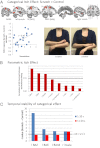Neural basis of contagious itch and why some people are more prone to it
- PMID: 23150550
- PMCID: PMC3511754
- DOI: 10.1073/pnas.1216160109
Neural basis of contagious itch and why some people are more prone to it
Abstract
Watching someone scratch himself can induce feelings of itchiness in the perceiver. This provides a unique opportunity to characterize the neural basis of subjective experiences of itch, independent of changes in peripheral inputs. In this study, we first established that the social contagion of itch is essentially a normative response (experienced by most people), and that the degree of contagion is related to trait differences in neuroticism (i.e., the tendency to experience negative emotions), but not to empathy. Watching video clips of someone scratching (relative to control videos of tapping) activated, as indicated by functional neuroimaging, many of the neural regions linked to the physical perception of itch, including anterior insular, primary somatosensory, and prefrontal (BA44) and premotor cortices. Moreover, activity in the left BA44, BA6, and primary somatosensory cortex was correlated with subjective ratings of itchiness, and the responsivity of the left BA44 reflected individual differences in neuroticism. Our findings highlight the central neural generation of the subjective experience of somatosensory perception in the absence of somatosensory stimulation. We speculate that the habitual activation of this central "itch matrix" may give rise to psychogenic itch disorders.
Conflict of interest statement
The authors declare no conflict of interest.
Figures


References
-
- Niemeier V, Gieler U. Observations during itch-inducing lecture. Dermatol Psychosom. 2000;1(Suppl 1):15–18.
-
- Ikoma A, Steinhoff M, Ständer S, Yosipovitch G, Schmelz M. The neurobiology of itch. Nat Rev Neurosci. 2006;7(7):535–547. - PubMed
-
- Herde L, Forster C, Strupf M, Handwerker HO. Itch induced by a novel method leads to limbic deactivations: A functional MRI study. J Neurophysiol. 2007;98(4):2347–2356. - PubMed
Publication types
MeSH terms
LinkOut - more resources
Full Text Sources
Medical
Research Materials

